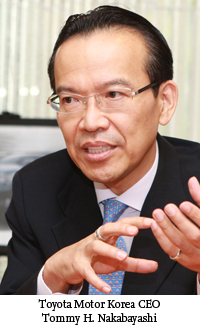
Toyota’s breakthrough

Japanese automaker aims to be pioneer in local hybrid market
The past three years may have been the most challenging period for Toyota Motor Korea CEO Tommy H. Nakabayashi since he took office in January 2010.
From the end of 2009 to early 2010, Toyota Motor was hit hard by massive recalls across the world. When the Japanese automaker tried to regain trust, Japan’s northern regions were devastated by an earthquake and tsunami, and severe flooding in Thailand also disrupted overseas production last year.
The firm has started to recapture lost market shares abroad but is still experiencing difficulties as it strives to make a complete comeback in the Korean market.
Nakabayashi has to catch up with rivals here as the yen remains strong against the won and there is fierce competition from German competitors such as BMW and Mercedes-Benz, which have secured strong positions.
Faced with such daunting tasks, he believes that the simplest yet most effective way is to “go back to basic points.”
“In the past three years, we, Toyota Korea, and our sales network, Lexus and Toyota dealers, couldn’t get into full swing,” Nakabayashi said Tuesday during an interview. “From this year, we’ve started a full swing and started to climb up and catch up with the market and our competitors.
“Actually, German automakers are competitors, but they are too strong competitors in this market and we are such a small player,” he said. “Countermeasures to compete with them are, actually there is no special way to do that. So we have to go back to the basic position again. It is my philosophy.”
He emphasized that Toyota and Lexus can provide the three elements that characterize a good car and wants customers to recognize them.
“A good car is one that looks nice, one you enjoy driving and one that you are satisfied with when buying it,” Nakabayashi said in Korean, the only time he did not speak in English during the interview.
Although he spoke humbly when describing the current position of Toyota in the local market, he has applied very aggressive marketing strategies to compete with rivals.
From this year, Toyota has introduced a new model almost every month and imported vehicles manufactured in the United States so that the global company can take full advantage of the free trade agreement (FTA) between the U.S. and Korea.
“We should study our own problems in the first place (to tackle the sluggish sales). Unfortunately, the lack of new models (was a problem). So to solve this problem, and to take an advantage of the FTA between the U.S. and Korea, we decided to import American-produced models like Camry and Sienna,” he said. “Thanks to the American models, we can add various kinds of new models.”
Following such efforts, the sales of Toyota soared 115 percent in the first half of this year, compared to the same period last year. The automaker plans to introduce about 10 new cars in the Korean market this year.
But Nakabayashi said another important strategy to improve business here is to give the automaker a new image that can be associated with advanced technology, namely hybrid cars.
“We need some symbolic messages of advanced technology. Now we’re strongly marketing hybrid technology for both Toyota and Lexus. Toyota is fuel-efficiency-oriented, and Lexus is a premium hybrid. We’re delivering the message to this market,” he said,
He believes that hybrid cars are important because they can create a new market for them here and actually there is increasing demand. In some sense, the hybrid car market is more promising than diesel-engine cars which are tremendously popular in Korea.
“Korean premium customers are very much like diesel-engine cars. It’s unbelievable,” he said. “Unfortunately, we didn’t make a lot of effort to advertize and market hybrid vehicles and the hybrid image during the past few years here. Customers think hybrid cars are only about fuel efficiency, but they are powerful, smooth and quiet and most importantly eco-friendly.”
Nakabayashi believes that the demand for hybrid cars will grow quickly and that Toyota and Lexus will lead their popularization.
The market share of hybrids has been increasing in the past few years. It stood at 4.2 percent in the first half of this year, up from 3.7 percent last year and from 2.5 percent in 2010.
Nakabayashi said he hopes Toyota will increase its market share in the Korean imported car market, which has been fast growing, but he has another goal first.
“We want to become the most beloved company in the imported car market. Sales targets and market share are important but we hope customers enjoy our vehicles,” he said.
To achieve this, he said his firm will also step up efforts to upgrade after-sales customer services.
He expects the market share for imported cars grow by up to 15 percent in the future and said there is still much room for improvement. The market share of imported cars is expected to top 10 percent this year for the first time.
“We haven’t offered a variety of choices and options (to customers). Of course, we have still a chance to improve. Customers should have various kinds of selections,” he said. <The Korea Times/Kim Tae-jong>



